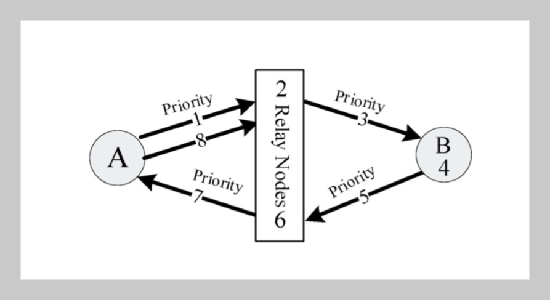REFERENCES
- [1] Xiong, Y., Sun, L., Niu, J. and Liu, Y., “Opportunistic Networks,” Journal of Software, Vol. 20, No. 1, pp. 124137 (in Chinese with English abstract) (2009). doi: 10.3724/SP.J.1001.2009.00124
- [2] Hull, B., Bychkovsky, V., Zhang, Y., Chen, K., Goraczko, M., Miu, A., Shih, E., Balakrishnan, H. and Madden, S., “CarTel: A Distributed Mobile Sensor Computing System,” Proceedings of the 4th International Conference on Embedded Networked Sensor Systems, pp. 125138, ACM (2006). doi: 10.1145/ 1182807.1182821
- [3] Juang, P., Oki, H., Wang, Y., Martonosi, M., Peh, L. S. and Rubenstein, D., “Energy-Efficient Computing for Wildlife Tracking: Design Tradeoffs and Early Experiences with Zebranet,” ACM SIGOPS Operating Systems Review, Vol. 36, No. 5, pp. 96107 (2002). doi: 10.1145/635508.605408
- [4] Ochiai, H., Ishizuka, H., Kawakami, Y. and Esaki, H., “A dtn-based Sensor Data Gathering for Agricultural Applications,” Sensors Journal, IEEE, Vol. 11, No. 11, pp. 28612868 (2011). doi: 10.1109/JSEN.2011. 2170562
- [5] Pentland, A., Fletcher, R. and Hasson, A., “Daknet: Rethinking Connectivity in Developing Nations,” Computer, Vol. 37, No. 1, pp. 7883 (2004). doi: 10.1109/MC.2004.1260729
- [6] Madden, S., Franklin, M. J., Hellerstein, J. M. and Hong, W., “TAG: A Tiny AGgregation Service for Ad-Hoc Sensor Networks,” Proceedings of the ACM Symposium on Operating System Design and Implementation (OSDI), p. 131 (2002). doi: 10.1145/ 1060289.1060303
- [7] Liu, X., Huang, Q. and Zhang, Y., “Combs, Needles, Haystacks: Balancing Push and Pull for Discovery in Large-Scale Sensor Networks,” Proceedings of the 2nd International Conference on Embedded Networked Sensor Systems, pp. 122133, ACM (2004). doi: 10.1145/1031495.1031510
- [8] Burleigh, S. and Scott, K., “Bundle Protocol Specification,” IETF Request for Comments RFC, 5050 (2007).
- [9] Fall, K., “A Delay-Tolerant Network Architecture for Challenged Internets,” Proceedings of the 2003 Conference on Applications, Technologies, Architectures, and Protocols for Computer Communications, pp. 27 34, ACM (2003). doi: 10.1145/863955.863960
- [10] Vahdat, A. and Becker, D., “Epidemic Routing for Partially Connected Ad Hoc Networks,” Technical Report CS-2000-06, Duke University (2000).
- [11] Harras, K. A., Almeroth, K. C. and Belding-Royer, E. M., “Delay Tolerant Mobile Networks (dtmns): Controlled Flooding in Sparse Mobile Networks,” NETWORKING 2005, pp. 11801192 (2005). doi: 10. 1007/11422778_95
- [12] Ramanathan, R., Hansen, R., Basu, P., Rosales-Hain, R. and Krishnan R., “Prioritized Epidemic Routing for Opportunistic Networks,” Proceedings of the 1st International MobiSys Workshop on Mobile Opportunistic Networking, pp. 6266, ACM (2007). doi: 10.1145/ 1247694.1247707
- [13] Lindgren, A., Doria, A. and Schelén, O., “Probabilistic Routing in Intermittently Connected Networks,” Service Assurance with Partial and Intermittent Resources, pp. 239254 (2004). doi: 10.1007/978-3-540-27767-5_24
- [14] Musolesi, M., Hailes, S. and Mascolo, C., “Adaptive Routing for Intermittently Connected Mobile Ad Hoc Networks,” Sixth International Symposium on a World of Wireless Mobile and Multimedia Networks, pp. 183189, IEEE (2005). doi: 10.1109/WOWMOM. 2005.17
- [15] Hui, P., Crowcroft, J. and Yoneki, E., “Bubble Rap: Social-Based Forwarding in Delay Tolerant Networks,” Proceedings of the 9th ACM International Symposium on Mobile Ad Hoc Networking and Computing, pp. 241250, ACM (2008). doi: 10.1145/1374618. 1374652
- [16] Bulut, E. and Szymanski, B. K., “Exploiting Friendship Relations for Efficient Routing in Mobile Social Networks,” IEEE Transactions on Parallel and Distributed Systems (2012). doi: 10.1109/TPDS.2012.83
- [17] Gao, W., Cao, G., Porta, T. La and Han, J., “On Exploiting Transient Social Contact Patterns for Data Forwarding in Delay Tolerant Networks,” IEEE Transactions on Mobile Computing, Vol. 99 (2011).
- [18] Zhou, Y., Levine, B. N. and Croft, W. B., “Distributed Information Retrieval for Disruption-Tolerant Mobile Networks,” Technical Report, CIIR Technical Report IR-412, University of Massachusetts Amherst (2005).
- [19] Fan, J., Chen, J., Du, Y., Wang, P. and Sun, Y., “Delque: A Socially-Aware Delegation Query Scheme in Delay Tolerant Networks,” IEEE Transactions on Vehicular Technology, Vol. 60, No. 5, pp. 21812193 (2011). doi: 10.1109/TVT.2011.2147342
- [20] Zhao, Y. and Wu, J., “Socially-Aware Publish/Subscribe System for Human Networks,” Wireless Communications and Networking Conference (WCNC), pp. 16, IEEE (2010). doi: 10.1109/WCNC.2010. 5506366
















